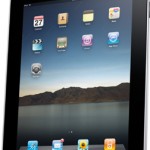The Paperless Book
 The paperless office may still be a long way off, but the forests of the world have what to celebrate: The paperless living room is here, now, and is coming to an e-book reader near you!
The paperless office may still be a long way off, but the forests of the world have what to celebrate: The paperless living room is here, now, and is coming to an e-book reader near you!
If e-books – and e-magazines, e-flyers, and any other reading material that was formerly available only in print – were still “iffy” until recently, that’s all changed with the arrival of Apple’s iPad. The iPad is far more than an e-reader, of course; you can watch Youtube videos and downloaded movies in brilliant, beautiful color on this device, and use it to download e-mail, surf the web, make internet phone calls, and do all sorts of other things.
But the truth is you can do all those things more efficiently and comfortably on computers, laptops, internet-connected TV sets, iPhones or other smart phones, etc. But you cannot sit back on a couch and curl up with a good book on any of them. Just try laying down in bed with a laptop e-book – or even worse, one on an iPhone – and see how long it takes for you to throw the thing away in frustration! But the iPad is perfectly sized for curling up, about the size of what they call a “trade paperback” (242.8 mm/9.56 inches tall, 189.7 mm/7.47 inches wide) – a good size for holding and reading in bed, on the living room couch, or anywhere else.
Now, I know what the naysayers out there are going to say. The iPad wasn’t the first e-reader; it’s expensive; the technology-challenged will never go for it; and (this one is for the editors), how can you tout a technology which, if left to its own devices, will eventually put book publishers and newspapers out of business?
Good questions, all. But as history has shown, once a technology has made itself available, it tends to grow and expand, and the rest of us have to learn to live with it. And, although it wasn’t first, the iPad seems to do the job of e-book reader better than it’s main competitor – Amazon’s Kindle (there are others, by the way; US bookseller chain Barnes and Noble’s Nook, an e-reader from Sony. Plus, other booksellers, like Borders, have e-reader development on their to-do lists).
But the proof is in the pudding, or, in the iPad’s case, the sales; by the end of June, after barely three months on the market, the iPad has sold more than 3 million units in the United States alone, which means that nearly one in one hundred Americans have one! That’s a record Amazon can only dream of – and is unlikely to even approach. In fact, even though the Kindle and the Nook came out long before the iPad, both Amazon and Barnes and Noble provide apps that users can use to read content downloaded or purchased from them on the iPad – a tacit admission of defeat in the e-book reader battle by both companies, it would appear. Note that the iPad is significantly more expensive than any of its competitors – an indication that people are looking for versatile devices that can lots of things, as the iPad can. Apple expects to sell millions more over the next year, so that by the end of 2011, they could be in the hands of as many as 30 million people worldwide!
And the iPad isn’t seen as a threat by publishers, especially newspaper publishers. In fact, in the industry, the iPad is considered a salvation of sorts; many magazines, like Time and Newsweek, have their own iPad apps, which allow readers to subscribe to or download a single e-issue, for pay – and unlike with internet content, people have shown they are quite willing to pay for content on portable devices, like iPhones and iPads. Magazines that don’t have their own apps can also build up an iPad readership, using Zinio, which has e-versions of nearly any magazine you can think of. Zinio is available on the web as well, and offers dozens of free samples so you can check out what e-reading is all about – but as I said, you haven’t read an e-magazine until you’ve read it on an e-reader (especially on the iPad). While fewer newspapers have yet developed their own apps, you can read 1,500 daily newspapers from around the world (including this one) by using PressReader, which brings you an exact digital copy of today’s paper. Everything is where you expect it to be, and each issue is just 99 cents apiece.
For many people, though, it’s the books that are the big draw to an e-reader. Until the iPad came out, the Kindle was the undisputed king of the e-books, but recently, Apple, opened its own e-book store – called, naturally, the iBook store. It’s got most of the content of the Kindle and Nook bookstores (although the iBook store is a bit pricier). And, according to this Wikipedia page, the iPad supports nearly every format of popular e-book – about twice as many as the Kindle and Nook. Among those formats is the ePub format, which is the format uses for its free library – which now has over a million free, public domain books you can read (mostly oldies, but goodies!). That ought to give you plenty of stuff to “curl up” with!
Related articles by Zemanta
- For Amazon, e-books outsell hardcovers (monicabulger.com)
- Publishing eBooks: Kindle, iPad, Nook, Kobo? [Publishing] (gizmodo.com)
- Surging sales show e-book reading is here to stay (blogs.consumerreports.org)
- Amazon Says E-Books Now Top Hardcover Sales (nytimes.com)





















